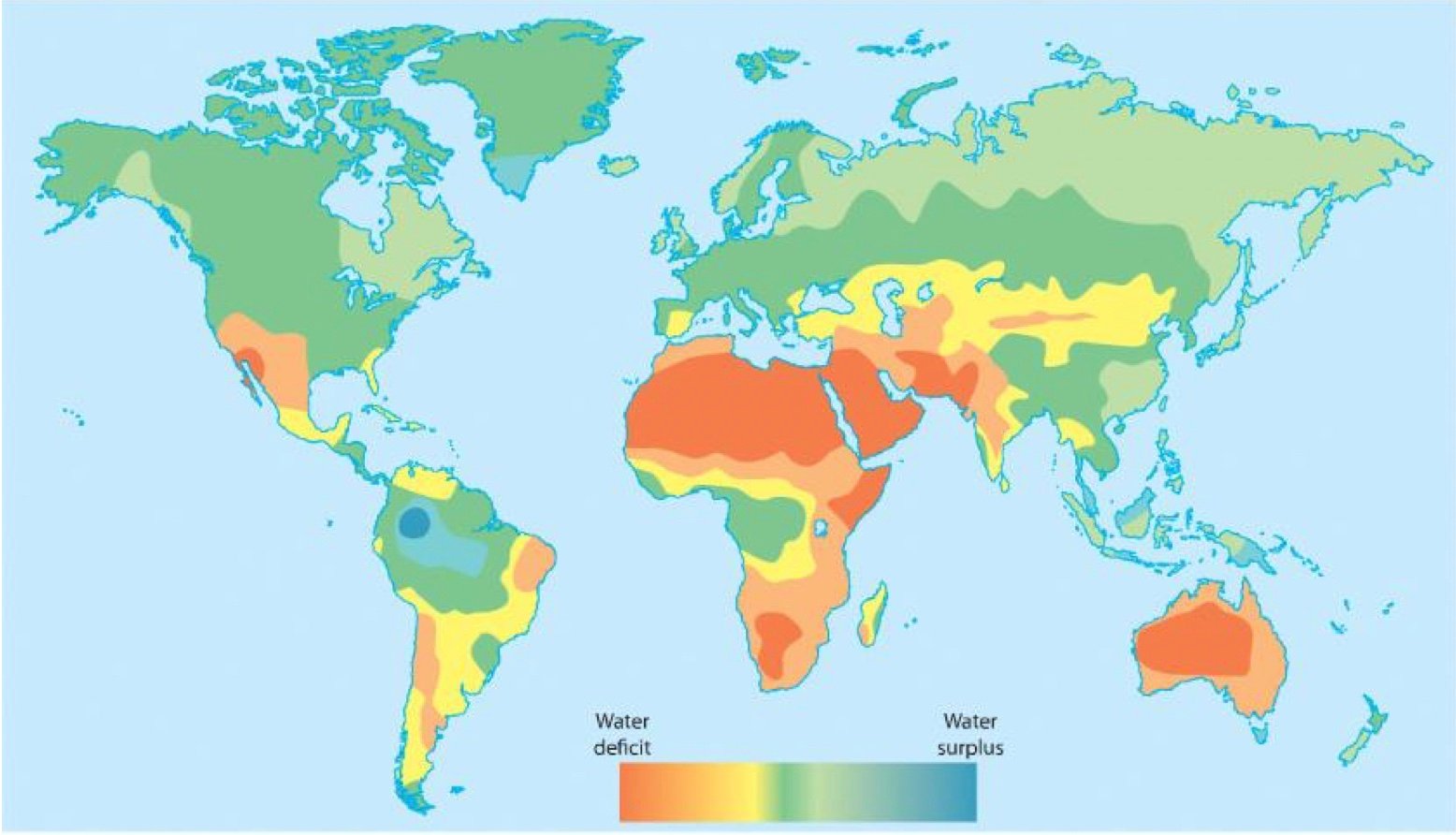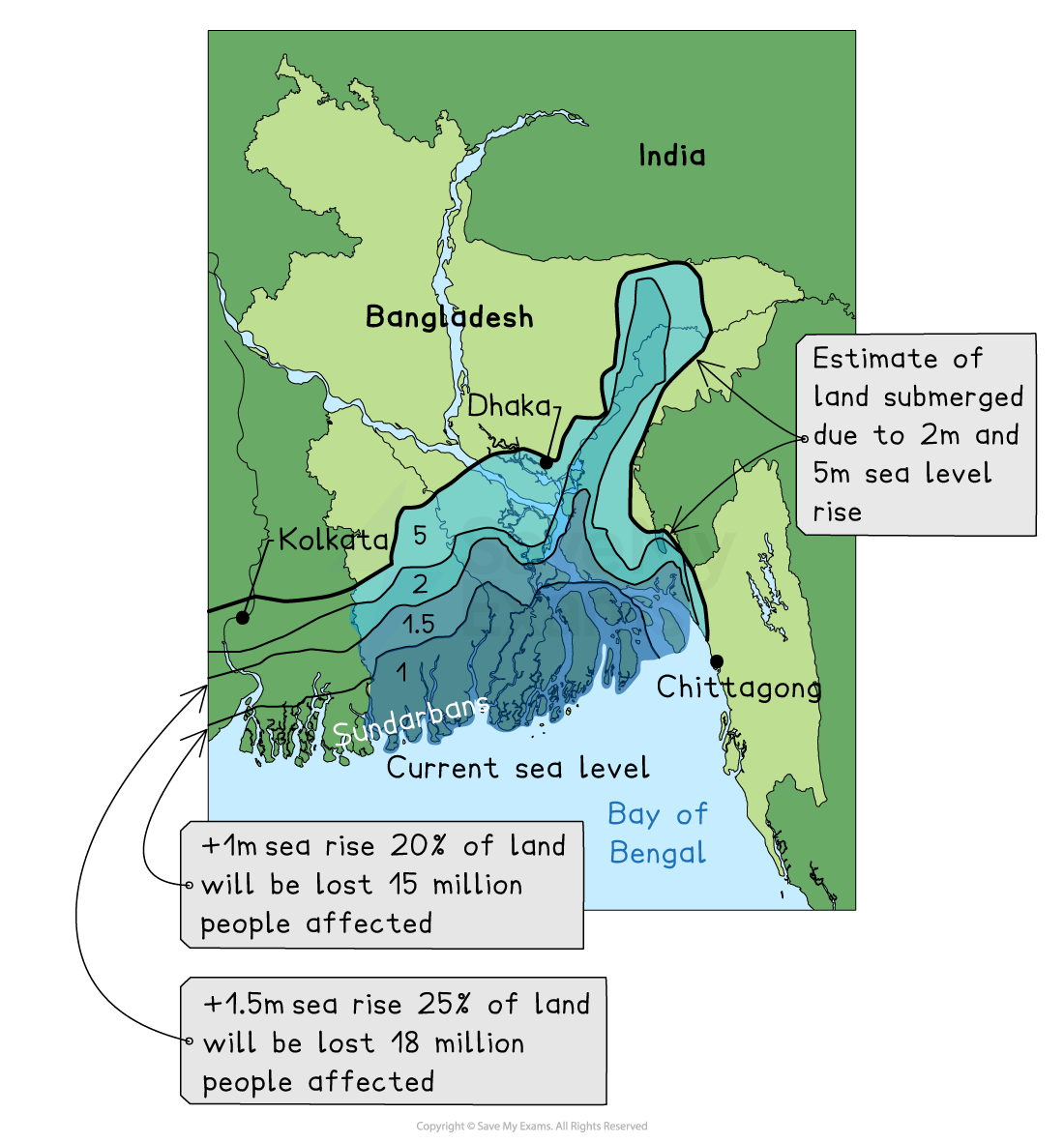What are the consequences of climate change? (WJEC Eduqas GCSE Geography B): Revision Note
Exam code: C112
Specification Link
The notes on this page cover part 2.4.3 of the WJEC Eduqas GCSE B Geography.
2.4.3 What are the consequences of climate change?
The consequences of climate change for people and environments.
Coverage must include the consequences on at least two of the following:
Farming and food supply
Wildlife and habitats
Water and water supplies
Where people live and population movement
Tourism and tourist destinations
Consequences of climate change on farming and food supply
Wheat and maize yields have been negatively impacted in many regions since 1960
Crop yields are estimated to continue reducing by over 20% as temperatures increase
The effects are that rice and soybean yields have been smaller in all major production regions
The largest impact has been on the price and production of food for daily consumption
Production has decreased
Prices have increased
A changing pattern of rainfall will also threaten crop production
Too little rain and crops will fail
Too much rain and crops will rot in the fields
Suitable areas for agriculture will change
Farmers may have to change their crops
Areas that could grow certain crops will have to change
Wheat grown in the USA will have to be grown in Canada
This would negatively affect the USA's economy while boosting Canada's
Reduced availability of water will mean that irrigation is limited or impossible
Food shortages will lead to malnutrition and famine
Consequences of climate change on wildlife and habitats
Animals and habitats are adapted to the climate in which they live
Any changes in the climate will impact on the wildlife and the habitats in those areas
Impact of climate change on biodiversity
Climate change can lead to habitat loss, changes in the food web and extreme weather events
All of these can reduce biodiversity
For example, coral bleaching due to increased sea temperatures reduces the variety of species in coral reefs
This can reduce the ability of coral reefs to cope with other changes, like ocean acidification or increased tropical storms
Impact of climate change on habitat fragmentation
Rising temperatures and changing precipitation patterns can shift habitats, leading to fragmented landscapes
Climate change can fragment habitats in various ways:
Increased desertification: expanding deserts can divide ecosystems, making it harder for species to find resources and migrate
Increased rates of forest fires: more frequent and intense fires can break up forest ecosystems, isolating populations and reducing biodiversity
Melting polar ice caps: loss of ice habitats can fragment the habitats of polar species like polar bears and penguins, affecting their ability to hunt and reproduce
Species in mountainous regions might be forced to move to higher altitudes, creating isolated populations
These changes reduce the resilience of ecosystems by isolating species and limiting their ability to adapt to new conditions
Changes in biomes
Movements of biomes
Biomes, such as forests, grasslands and tundra, may shift towards the poles or higher altitudes as species (including plants) shift ranges to find suitable climates
For example, in North America, temperate forests are moving northward, slowly replacing boreal forests
As species move to new areas or experience changes in their habitats, they may face new competition, predation, or disease
Transformation of existing biomes
Current biomes may change in structure and composition
For example, the Arctic tundra is transforming into shrubland as warmer temperatures allow shrubs to grow
Seasonal cycles are changing, e.g.
Plant species are producing flowers earlier in the year
Animals are producing young earlier in the year
Bird migratory patterns may lose their synchronisation with their habitats, leading to a change in migration patterns
Polar ice and glaciers are retreating; it is thought that there may soon be no summer ice in the arctic if rates of warming there continue
The loss of glacier ice from mountain ranges may affect the water supplies of many people and surrounding wildlife
Loss of unique biomes
Some biomes may disappear if conditions become unsuitable for the species that inhabit them
For example, alpine regions may lose their unique flora and fauna as temperatures rise and snow cover decreases
This can lead to declines in population numbers and even extinction in some cases
Consequences of climate change on water and water supplies
Climate change can lead to alterations in precipitation patterns
This results in changes in water availability
Some regions may experience increased rainfall and flooding
Others may face more frequent and severe droughts
These both impact water resources for agriculture, drinking water, and ecosystems
There will be reduced availability and quality of freshwater resources due to the changes in precipitation patterns and increased evaporation
Water stress
Water stress occurs when available water resources are not sufficient to meet the demand
The number of people suffering water stress is increasing
Approximately 4 billion people around the world suffer water stress for at least one month a year
The UN Predicts that 5 billion people could face water shortages by 2050

Impact of climate change on where people live
Almost 32 million people were displaced by weather-related hazards in 2022
Over 200 million people may be forced to move by 2050
The causes of the displacement include:
Rising sea levels
Drought
Food and water shortages
Increased health risks
Rising sea levels
Sea levels have been rising faster in recent years
Increased storm frequency and severity
These will both lead to increased flooding
Increased flooding lead to displacement of large numbers of people
The migration of people from the south of Bangladesh
People are relocating to urban areas due to coastal erosion and flooding caused by sea level rise

Drought
Less frequent precipitation and increased evaporation lead to drought
As areas become drier, they become more vulnerable to drought
In parts of East Africa between 2020 and 2022 there were five failed rainy seasons
This displaced over 1.2 million people in Somalia
From 2011 to 2017, California experienced extreme drought conditions
By January 2014, the entire state was in a drought emergency, with Central Valley being the worst-affected area
With continued lower than normal precipitation and overdependence on the Colorado River, water supplies dropped

Food and water shortages
Food shortages and price spikes following extreme weather events, such as hurricanes or droughts
Water rationing in Cape Town, South Africa, during a prolonged drought leading to severe water shortages (2017-2018)
Decline in wheat yields in Australia due to heat stress and reduced rainfall
Outbreak of coffee leaf rust in Central America resulting in significant losses for coffee farmers
Increased health risks
Increased temperatures and lack of precipitation may lead to the spread of diseases:
Italy has experienced cases of malaria since 2017, when it was previously a malaria-free area
An additional 280 million people may be affected by malaria
Waterborne diseases are more likely to spread
Heat waves may become more frequent
Heatstroke, dehydration and sunburn increase during heat waves
Heatwaves in Europe (2003) resulted in thousands of deaths, particularly among vulnerable populations such as the elderly
Stagnant air during heat waves increases air pollution levels:
Respiratory diseases increase and those suffering from respiratory illnesses such as asthma may be more affected
Increased temperatures negatively affect people with cardiopulmonary diseases
Diets may be restricted by food shortages leading to malnutrition and famine
Impact of climate change on tourism
Places which are popular with tourists are often reliant on their climate as part of the attraction
The tourist industry in these areas may be negatively affected by an increase in:
Tropical storm frequency and severity
Water shortages
Melting of snow and ice leading to the closure of ski resorts
In the Caribbean tourism makes a significant contribution to the economies of many countries
Tourism employs over 700,000 people
Many Caribbean countries' popularity is due to their climate
Changes to the climate which are already occurring in the Caribbean include:
Average temperature has increase by over 1°C since the 1950s
An increase in water temperatures
Drought
Changes in coral reefs
More severe and frequent storms
The 2017 hurricane season was particularly severe with Hurricane Irma and Marie causing destruction over many islands
Over 90% of Dominica's buildings were destroyed
In 2020, there were 30 named storms, many of which caused devastation to people living in the Caribbean
These all impacted on the tourist industry
Many tourist resorts did not reopen; others took many months, even years to rebuild
Examiner Tips and Tricks
In the exam you will be expected to have knowledge and understanding of the consequences of climate change on two of the following:
Farming and food supply
Wildlife and habitats
Water and water supplies
Where people live and population movement
Tourism and tourist destinations

Unlock more, it's free!
Did this page help you?